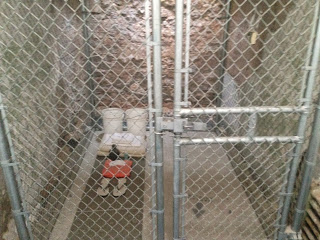Museum Practicum: Objective Blog: National Constitution Center
Oktavia LaBarge, September 26, 2013
Title: Experience Room: Prohibition
Year: Museum opened in 2003
Material: Multimedia
Creator: Unknow
Collection: National Constitution Center: The Story of We the People
This is an experience room in the National Constitution Center which addresses prohibition. In 1920, the manufacturing, sale, or transportation of liquor was made illegal. This room asks audiences to step back into history in order to learn why liquor was prohibited and the reactions to this prohibition. On the back wall is a black and white photograph of a group of women called the Women’s Christian Temperance Union. These women were marching on
big cities to discuss the issues that alcohol was causing to their families and the United States. This is an important period in American history because it was the only time that an Amendment in the United States Constitution was repealed. After the American Revolution, drinking had increased substantially, as a result the Temperance Movements began. The Temperance Movement developed out of Protestant churches to end the abuse of alcohol, which led to sin. In 1919, the 18th Amendment was ratified and prohibited the sale and manufacture of alcohol. On the wall to the right of the large photograph is a door with a smaller door that opens to reveal image of men and women drinking. In the image the women are dressed provocatively for the period and men are illegally drinking alcohol. As a result of prohibition, gangsters would smuggle alcohol into the United States and created speakeasies. Speakeasies were bars which illegally sold alcohol to citizens.
On the wall to the right of the large photograph is a door with a smaller door that opens to reveal image of men and women drinking. In the image the women are dressed provocatively for the period and men are illegally drinking alcohol. As a result of prohibition, gangsters would smuggle alcohol into the United States and created speakeasies. Speakeasies were bars which illegally sold alcohol to citizens.
On the glass wall opposite of the door is two labels. One discusses the work and success of the Women’s Christian Temperance Union. The label is dated Wednesday, January 16th, 1919, and is a first-person interpretation style. This means that the reader of the label is meant to feel as though they were taken back in time and are reading something from 1919. The label tells the visitor that in 1919 the new amendment had been added to the Constitution, banning alcohol. The second label is also in first-person interpretation, from 1933. This label states that the prohibition has proved unsuccessful and has caused more crime. This reveals to the audience that in 1933 the 18th article of the amendment to the Constitution has been repealed.
This experience room is on display to remind the visitors of the National Constitution Center of the many changes that the Constitution had. The prohibition was the only time that an Amendment in the Constitution had been repealed, revealing that the writers of this important document considered all aspects of the world and made the amendments board enough to fulfill Americans needs.
The Nation Constitution Center’s exhibition reveals the timeline of changes that were made to the Constitution throughout American history. The nearby objects contribute to the understanding of the prohibition by revealing the events that led up to this moment in time. To learn more about prohibition, the National Constitution Center has a traveling exhibition, called American Spirits: The Rise and Fall of Prohibition which could teach one more in depth about the prohibition. One could also visit a bar that was once a speakeasy to relive the experience of the prohibition. In Philadelphia there are a lot of bars that once illegally sold alcohol to its customers, such as McNally’s Quick Lunch or McGillin’s Old Ale House.
Someone who might not be interested in learning about prohibition may be someone from a country which currently has alcohol prohibition laws. Many of these countries with prohibition laws are because the citizens are Muslim. In the Muslim religion, alcohol is illegal because it causes impaired judgement and clouds the mind . Followers of the Muslim religion would not be interested in learning about the prohibition, because they currently are prohibited. Someone of the Muslim religion would probably tell a different narrative about this experience room. They probably would discuss why it was a bad decision for the United States to repeal the prohibition of alcohol. They may also discuss their religious reasons for choosing not to drink, or perhaps they might be able to relate to how people felt about not being allowed to consume alcohol.
Visitors of the National Constitution Center who are not from the United States also might not be interested in learning about prohibition. These visitors may not understand the importance of this period because they would not grow up learning about American History in school. Without reading the text they would probably believe the pictures were of people marching against prostitution, since the small hidden image reveals women dressed inappropriately. Children would also probably not be interested in learning about the prohibition because they do not understand the allure of alcohol.
To create interest about the prohibition, I would create a bar crawl event that takes visitors to different bars that once sold alcohol illegally. During this bar crawl, I would invite the owners of bars to share the history of their bar. This would generate community interest and the teach the audience about local history. Another way to further engage viewers with this object would be to ask people from countries where alcohol is currently prohibited and hear about their experiences. Lastly, to further engage visitors with this object the museum could host an event that had speakers discuss the prohibition and serve different cocktails that once were served during this time.














